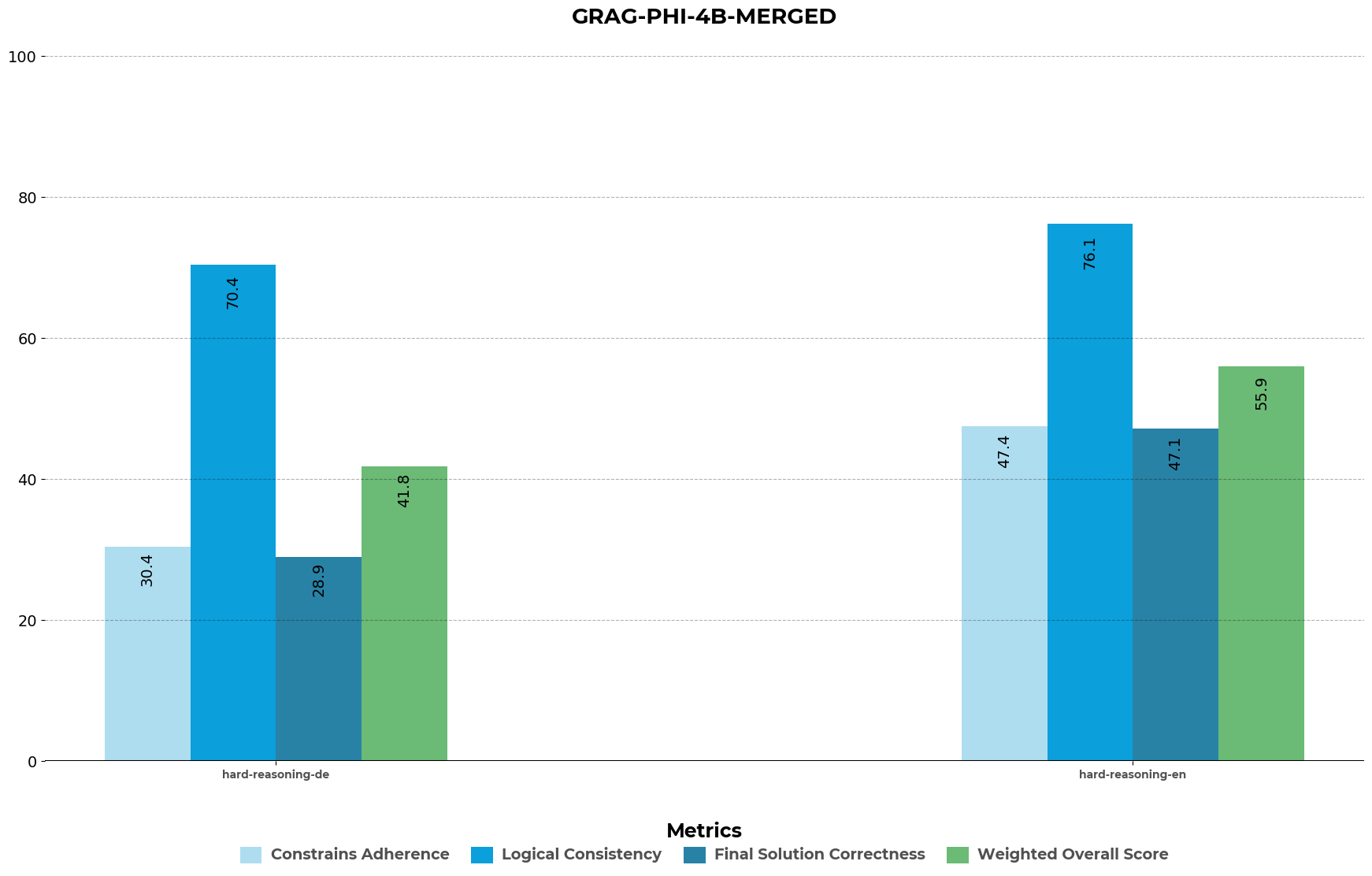GRAG-PHI-3.5-MINI-4B-MERGED-HESSIAN-AI
GRAG (German Retrieval Augmented Generation) models are designed for the German-speaking market, enabling innovation and AI solutions to drive German research collaboration in business-focused Generative AI by 2025
Model Details
The core models released in this batch are the following:
| Size | Training Tokens |
|---|---|
| GRAG-PHI-CPT | 507.47 million |
| GRAG-PHI-SFT | 2.03 billion |
| GRAG-PHI-ORPO | 2.0577 billion |
Model Description
- Developed by: Avemio AI Team
- Supported by: Hessian AI
- Model type: a Transformer style autoregressive language model.
- Language(s) (NLP): German, English
- License: The code and model are released under MIT.
- Contact: [email protected]
Model Sources
- Training Study: Training Study
- Repositories:
- Training: Colab-Notebook
- Evaluation code:
- Technical blog post:
Merge Details
Merge Method
This model was merged using the SLERP merge method.
Models Merged
The following models were included in the merge:
Configuration
The following YAML configuration was used to produce this model:
slices:
- sources:
- model: avemio/GRAG-PHI-3.5-MINI-4B-SFT-HESSIAN-AI
layer_range: [0, 32]
- model: avemio/GRAG-PHI-3.5-MINI-4B-ORPO-HESSIAN-AI
layer_range: [0, 32]
merge_method: slerp
base_model: avemio/GRAG-PHI-3.5-MINI-4B-ORPO-HESSIAN-AI
parameters:
t:
- filter: self_attn
value: [0, 0.5, 0.3, 0.7, 1]
- filter: mlp
value: [1, 0.5, 0.7, 0.3, 0]
- value: 0.5
dtype: bfloat16
Uses
Inference
Quickly get inference running with the following required installation: Now, proceed as usual with HuggingFace:
from transformers import AutoModelForCausalLM, AutoTokenizer
model_name = "avemio/GRAG-PHI-3.5-MINI-4B-MERGED-HESSIAN-AI"
model = AutoModelForCausalLM.from_pretrained(
model_name,
torch_dtype="auto",
device_map="auto"
)
tokenizer = AutoTokenizer.from_pretrained(model_name)
im_end_token_id = tokenizer.convert_tokens_to_ids('<|im_end|>')
im_start_token_id = tokenizer.convert_tokens_to_ids('<|im_start|>')
messages = [
{"role": "system", "content": "Folge den Anweisungen des Benutzers. Bevor du deine finale Antwort gibst, schildere deine Überlegungen zur Lösung des Problems."},
{"role": "user", "content": "Ferdinand steht vor der Herausforderung, eine faire Besuchsregelung für seine drei Kinder zu finden, die den Bedürfnissen jedes einzelnen Kindes gerecht wird. Jedes Kind hat unterschiedliche Vorlieben und Bedürfnisse, die in den Besuchsplan integriert werden müssen. Er muss sicherstellen, dass die Regelung sowohl den Interessen der Kinder als auch den rechtlichen Vorgaben entspricht. Ferdinand hat eine Woche Zeit, um einen Vorschlag zu erarbeiten, den er mit seinem Anwalt besprechen kann."}
]
text = tokenizer.apply_chat_template(
messages,
tokenize=False,
add_generation_prompt=False
)
model_inputs = tokenizer([text], return_tensors="pt").to(model.device)
generated_ids = model.generate(
**model_inputs,
max_length=2024,
temperature=0.01,
do_sample=False,
#bos_token_id=im_start_token_id,
eos_token_id=im_end_token_id,
pad_token_id=tokenizer.eos_token_id,
repetition_penalty=1.1,
num_return_sequences=1,
top_k=40,
top_p=0.95,
)
generated_ids = [
output_ids[len(input_ids):] for input_ids, output_ids in zip(model_inputs.input_ids, generated_ids)
]
response = tokenizer.batch_decode(generated_ids, skip_special_tokens=True)[0]
Fine-tuning
We are providing a comprehensive Google Colab notebook to guide users through the process of fine-tuning our model, complete with detailed instructions, essential dependencies, and configurable settings. Colab-Notebook.
GRAG-LLM-EASY-BENCHMARK EVAL
The evaluation was performed using seven subsets, focusing on extraction recall, question answering (QA) with multiple references, and time difference reasoning. Relevant context and summarization were treated as distinct subsets, each playing a crucial role in the evaluation process. For relevant context, the model's ability to identify and extract pertinent information from the source material was assessed. In contrast, the summarization subset evaluated the model's capability to generate concise and accurate summaries based on the relevant context.
Four evaluation metrics were employed across all subsets: language quality, overall correctness, instruction following, and an overall score.
- Language quality: This metric focused on the overall linguistic quality of the outputs, considering factors such as grammar, fluency, and clarity.
- Overall correctness: The accuracy and correctness of the content were evaluated under this metric.
- Instruction following: This metric assessed the model's ability to follow specific instructions provided for each task.
- Overall score: This metric combined the results from the previous three metrics, offering a comprehensive evaluation of the model's capabilities across all subsets.
| Metric | Vanilla-Phi-3.5-Mini-4B | GRAG-PHI-SFT | GRAG-PHI-ORPO | GRAG-PHI-MERGED | GPT-3.5-TURBO |
|---|---|---|---|---|---|
| Average Language Quality | 75.11 | 78.88 | 78.13 | 85.41 | 91.86 |
| OVERALL SCORES (weighted): | |||||
| extraction_recall | 18.0 | 37.5 | 32.0 | 61.8 | 87.2 |
| qa_multiple_references | 65.8 | 70.6 | 74.8 | 84.8 | 77.2 |
| qa_without_time_difference | 71.2 | 88.0 | 87.3 | 88.0 | 83.1 |
| qa_with_time_difference | 64.6 | 89.3 | 86.9 | 89.1 | 83.2 |
| relevant_context | 72.3 | 72.8 | 69.1 | 84.4 | 89.5 |
| summarizations | 74.6 | 83.2 | 81.1 | 84.9 | 86.9 |
GRAG-LLM-HARD-BENCHMARK EVAL

| Metric | Vanila-PHI-4B-Instruct | GRAG-PHI-Merged | GPT-3.5-TURBO | GPT-4o | GPT-4o-mini |
|---|---|---|---|---|---|
| OVERALL SCORES (weighted): | |||||
| hard_reasoning_de | 42.8 | 41.8 | 37.9 | 62.9 | 58.4 |
| hard_reasoning_en | 50.8 | 55.9 | 48.3 | 61.7 | 62.9 |
Architecture
| Parameter | GRAG-PHI-MERGED |
|---|---|
| d_model | 3072 |
| num heads | 32 |
| num layers | 32 |
| MLP ratio | 2.66 |
| LayerNorm type | RMSNorm |
| pos embeddings | RoPE |
| attention variant | Standard Multi-Head Self Attention with sliding-window of 2047 |
| biases | none |
| block type | sequential |
| activation | SiLU |
| sequence length | 131072 |
| weight tying | bfloat16 |
Bias, Risks, and Limitations
Like any base language model or fine-tuned model without safety filtering, it is relatively easy for a user to prompt these models to generate harmful and generally sensitive content. Such content can also be produced unintentionally, especially in the case of bias, so we recommend users consider the risks of applications of this technology.
Otherwise, many facts from GRAG-PHI-MERGED or any LLM will often not be true, so they should be checked.
Model Card Contact
For errors in this model card, please contact ([email protected]).
The GRAG AI Team
- Downloads last month
- 194